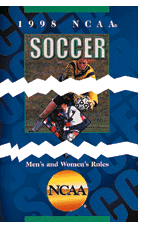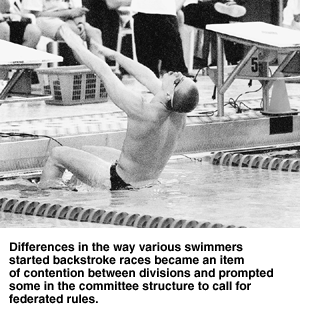The NCAA News - News and Features
The NCAA News -- March 15, 1999
New structure, same game
Federated governance hasn't penetrated common playing rules among divisions
BY GARY T. BROWN
STAFF WRITER
 When the Association restructured in 1997, it did so to allow the three member divisions the freedom to tailor a set of rules to better meet their own needs -- at least off the fields and courts. When the Association restructured in 1997, it did so to allow the three member divisions the freedom to tailor a set of rules to better meet their own needs -- at least off the fields and courts.
But rules on the fields and courts weren't part of the package. Playing rules in each sport remained an Association-wide endeavor, with no variation per division. Swimmers in each division use the same strokes, the play clocks are all set at 25 seconds in football and the offside rule is the same in all divisions of soccer.
That's the way it's always been -- and most say it's with good reason. But as more and more situations arise where the idea of federated rules is broached, it raises the question of whether that's the way it always will be. If the NCAA can federate legislation by division, why not playing rules, too?
Soccer coaches have longed for separate substitution rules that would accommodate differences in participation philosophies among divisions. Swimming had to call for a moratorium on the debate of how backstrokers began their races because a compromise couldn't be found for an issue that divided Divisions I and III. Rules changes with financial implications in football and track have ruffled feathers among divisions. And most recently, the ongoing issue of baseball bat standards has even raised the possibility of different divisions using different equipment in their championships.
So far, the Association's longstanding policy of establishing common playing rules per division has stood fast. But as divisions become more comfortable in establishing their own way of governance, is it reasonable to assume that playing rules could be the next domino to fall?
Not necessarily, according to several rules committee members who say that path is too fraught with practical -- and philosophical -- obstacles.
"I'm not naive enough to say it will never happen," said William Rowe, director of athletics at Southwest Missouri State University and chair of the NCAA Baseball Rules Committee. "But it could be seen as an affront to those people in one division if they thought they were being legislated against just because they were in a certain division."
Rowe's committee is the latest to be confronted with an issue ripe for federating. The group developed a set of bat performance standards designed to ensure player safety, but the three divisional championships committees did not implement the standards uniformly for the 1999 championships, which set the stage for the possibility of regular-season games -- particularly in Divisions II and III -- in which opposing teams could use different bats.
Several conferences in Divisions II and III worked to avert such a scenario by adopting strict bat performance standards for conference play while allowing institutions to determine their respective nonconference policies. Others, like the Wisconsin Intercollegiate Athletic Conference, urged member schools to seek an agreement with previously scheduled nonconference teams to use only those bats permitted for conference play, and if an agreement couldn't be reached, then conference members were asked to consider canceling the game.
Had the bat rule been federated, a Division III team using wood bats might have played against a Division I or II team using metal bats, which would have skewed the competitive balance of the game.
The Baseball Rules Committee didn't ask to have the bat issue federated, but it ended up serving as an example of how a playing rule might become split along divisional lines. Rowe said it's a good example of why interdivisional play, which is common in baseball and several other sports, is one of the ties that bind playing rules as Association-wide.
"Invariably, if you play each other, that's the determining factor," he said. "The bat issue is an example."
Self-serving interests
Soccer, too, has maintained the importance of common playing rules due to interdivisional play, but several camps remain divided on the issue of substitution, which has led to the common-rules policy being challenged during previous rules committee meetings. Many Division I coaches favor fewer substitutions -- like the international rule -- but are typically opposed by Division III coaches, who favor increased participation.
C. Cliff McCrath, secretary-rules editor for the Men's and Women's Soccer Rules Committee, said the thinking behind federating substitution rules may be an attempt to curtail what some coaches see as the use of substitution to gain a competitive advantage.
"There's an exclusive group of people who might feel better about the chances in competition if they could guarantee that the other coach couldn't use more than five subs in a game," said McCrath, who also coaches men's soccer at Seattle Pacific University. "The issue of federation in this case isn't anything but a way to arbitrarily dictate substitution. The demand for federated rules usually comes from somebody who wants the game changed for his or her own particular needs."
Susan Petersen-Lubow, director of athletics at the U.S. Merchant Marine Academy and secretary-rules editor for the Men's and Women's Swimming and Diving Committee, also recalled a rules issue that once separated Divisions I and III, literally from head to toe.
She said coaches in each division were at odds over where backstrokers could place their toes at the start of the race. Division III wanted to modify the rule that required a swimmer to place his or her feet flat on the starting wall with the toes under the line of the water. Because so many backstrokers, particularly at the Division III level, were slipping upon takeoff, coaches wanted to allow competitors to curl their toes over the rim of the gutter in order to stabilize the takeoff.
Petersen-Lubow said it was more of a Division III problem because many of the facilities at that level weren't equipped with touchpads that featured state-of-the-art grips, which Division I schools typically could afford.
"Also, swimmers who weren't swimming year-round or weren't as experienced as some of the Division I swimmers were having difficulty," she said. "And you found those cases more in Division III where the philosophy is one of participation and not necessarily training for the Olympics."
When the issue emerged in the early 1990s, Division III was solidly in favor of changing the rule and was prepared to propose that the rule be federated. But Petersen-Lubow said as time went on -- and as more coaches realized the impact that federating the rule might have on the sport -- the votes began to dwindle.
"Over time, Division III said no, even though they'd like to see the toes in the gutter to help their swimmers, they didn't want to have a different set of rules," she said. "And ironically, when the Association restructured and Division III had the ability to at least discuss it, they didn't even want to. They wanted to keep the rules unified."
Legislating to skill level
Jean Lenti Ponsetto, who chairs the Division I Championships/Competition Cabinet, the body that would have a significant say in whether a playing rule is federated, said swimming's epiphany is an example of why rules committees can't become caught in the trap of legislating according to skill level.
 "It's in the best interests of the student-athletes for us to have the same set of playing rules," she said. "While there are probably differences competitively between a vast majority of the student-athletes at the Divisions I, II and III levels, there still is a fair number of athletes in Divisions II and III who want to have an opportunity to participate internationally. We owe them that opportunity." "It's in the best interests of the student-athletes for us to have the same set of playing rules," she said. "While there are probably differences competitively between a vast majority of the student-athletes at the Divisions I, II and III levels, there still is a fair number of athletes in Divisions II and III who want to have an opportunity to participate internationally. We owe them that opportunity."
Ponsetto, senior associate director of athletics at DePaul University, also said that variations in playing rules might work against schools in recruiting.
"Ultimately, everyone wants to be able to maximize their potential," she said. "If you're going to limit that opportunity by a playing rule or by having different sets of standards, you'd be potentially disadvantaging an institution from a recruiting standpoint."
John Adams, the Football Rules Committee's secretary-rules editor, said his group has considered the idea of federation before. However, each time a rules proposal comes up that might advantage one division over another, it's thrown out.
"I've been involved with the committee since 1975 and the idea has come up several times, but it's never had strong support," he said. "If we did have federated rules, people would be very confused. We've got enough confusion now between high-school rules, college rules and professional rules."
McCrath said part of the reason for common rules is the sheer convenience of game administration. Not only do teams from different divisions play each other, but other groups such as the National Association of Intercollegiate Athletics and various youth leagues use NCAA playing rules. McCrath said federation might turn simple game management into a headache.
"Just the business of orchestrating something where you continue to play across divisional lines would call for such clever execution that it would take a Dick Clark to produce each game," he said.
Is the climate changing at all? Adams doesn't think so.
"We've talked about limited substitution over the years as a difference between divisions," he said. "But it's never come to a vote. I don't anticipate that either. College football should be for all divisions."
Petersen-Lubow said any likelihood of federation in swimming would come not in the way the strokes are performed but in the way meets are scored. Debate still bubbles up regarding whether more points should be awarded to the top swimmers in each event or spread out more among all participants in the event to place more importance on a team approach.
Those differences in philosophy continue to keep the idea of federation alive, but few see a groundswell of support to overhaul the common-rules policy. Thus, in an era during which the relationships between divisions seem to be increasingly taxed, unity still carries the day, at least on the field.
"The sport is swimming and diving," Petersen-Lubow said. "It's not called Division I swimming and diving, Division II swimming and diving or Division III swimming and diving. The feeling is that if we federated, we'd be doing our sport a disservice by fragmenting like that and just coming up with rules to satisfy some."
|